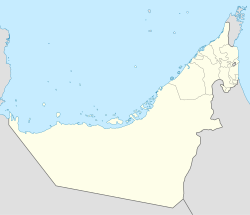Ras Ash
Script error: No such module "AfC submission catcheck".
Ras Ash راس أش | |
|---|---|
 Small mountain village located in the Hajar Mountains (UAE) | |
| Coordinates: 25°58′04″N 56°10′04″E / 25.96778°N 56.16778°ECoordinates: 25°58′04″N 56°10′04″E / 25.96778°N 56.16778°E ⧼validator-fatal-error⧽ | |
| Country | |
| Emirate | Ras al Khaimah |
| Area | |
| • Total | 0.25 km2 (0.10 sq mi) |
| Elevation | 1,450 m (4,757 ft) |
| Population (2023) | |
| • Total | 1 |
| Time zone | UTC+04:00 |
Ras Ash is a small agricultural and livestock village, located at 1,450 m altitude, northeast of the United Arab Emirates (UAE), in the Al Hajar Mountains, Emirate of Ras al Khaimah.
The village has about 15 houses, huts and stone cabins; corrals and terraces supported by dry stone walls, without mortar, which allow water and soil to be retained, destined for pastures and other agricultural uses; pipelines to collect runoff water; sheepfolds; and some other constructions in ruins, although at present it is only inhabited by a single person. Inaccessible by road.
Ras Ash is well known by hikers and climbers, as it is located on the itinerary of the popular mountain path Stairway to Heaven,[1] a historic donkey trail that today continues to be the preferred route of communication to access the village and for the transfer of goods, on the back of donkeys, from and to the Wadi Litibah and the town of Ghalilah, on the coast of the Persian Gulf.
Geography[edit]
Ras Ash is located to the west and very close to the border between the United Arab Emirates and Oman, a short distance from the summit of Jebel Jais / Jabal Bil Ays (1,911 m),[2] located in Oman, and on the edge of a large cliff that forms the eastern slope of Wadi Barut,[3] a tributary of Wadi Ghalilah.
Population[edit]
The area of Ras Ash was historically inhabited by the semi-nomadic tribe Shihuh, section of Bani Hadiyah (Arabic: بني هدية ), and section of Bani Shatair (Arabic: بني شطير ), which occupied, among other territories, the tribal area of Bani Bakhit.[4]
Toponymy[edit]
The name of this village was recorded in the documentation and maps produced between 1950 and 1960 by the British Arabist, cartographer, army officer and diplomat Julian F. Walker,[5] during the work he carried out to establish borders between the then-called Trucial States, later completed by the Ministry of Defense of the United Kingdom, on 1:100,000 scale maps published in 1971.
By oral tradition, the village is also known by the name of Ras al Ghash,[6] but it should not be confused with that of another nearby village, located in the Sultanate of Oman, identified as Ra's al Waḩḩ.[7]
Gallery[edit]
-
View of Ras Ash, overlooking the Wadi Ghalilah and three of its tributaries: Wadi Litibah, Wadi Barut and Wadi Khabb, from the top of the cliff that forms the eastern slope of Wadi Barut.
-
Small mountain village located in the Hajar Mountains (UAE), at an altitude of 1450 m. Very close to the border between UAE and Oman. The village is on the itinerary that follows the well-known mountain trail Stairway to Heaven.
References[edit]
- ↑ "Hitting the heights with the Stairway to Heaven in Ras Al Khaimah". The National. Retrieved 2018-09-16.
- ↑ Peakbagger - Jabal Bil Ays
- ↑ Mindat.org - Wādī Barut
- ↑ Getamap.net - Banī Bakhīt / Ra's al Khaymah
- ↑ FCO 18/1932 1958 - Sketch map drawn by Julian Walker for boundary delimitation: Ras Al Khaimah - The National Archives, London, England
- ↑ GeoNames - Ras al Ghash
- ↑ Mindat.org - Ra’s al Waḩḩ
Maps and bibliography[edit]
- William Lancaster; Fidelity Lancaster (2011). Honour Is in Contentment. Life Before Oil in Ras Al-Khaimah (UAE) and Some Neighbouring Regions. ISBN 9783110223392, 3110223392
- Map of Trucial States, Muscat and Oman - Rams - Scale 1:100 000 - Published by D Survey, Ministry of Defence, United Kingdom (1971) - Edition 3-GSGS - The National Archives, London, England
- Heard-Bey, Frauke (2005). From Trucial States to United Arab Emirates : a society in transition. London: Motivate. ISBN 1860631673. OCLC 64689681.
External links[edit]
![]() Media related to Ras Ash at Wikimedia Commons
Media related to Ras Ash at Wikimedia Commons
This article "Ras Ash" is from Wikipedia. The list of its authors can be seen in its historical and/or the page Edithistory:Ras Ash. Articles copied from Draft Namespace on Wikipedia could be seen on the Draft Namespace of Wikipedia and not main one.




